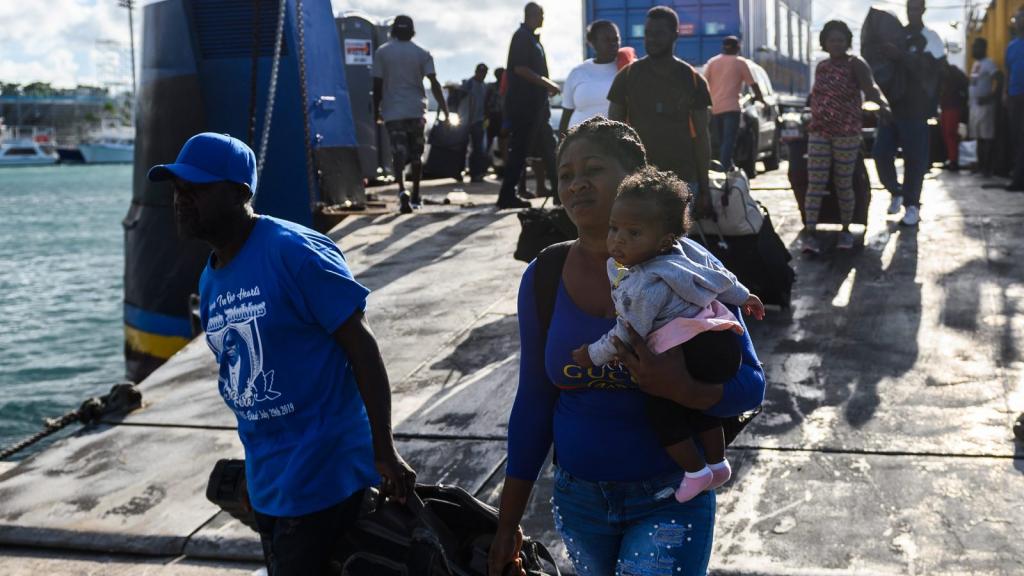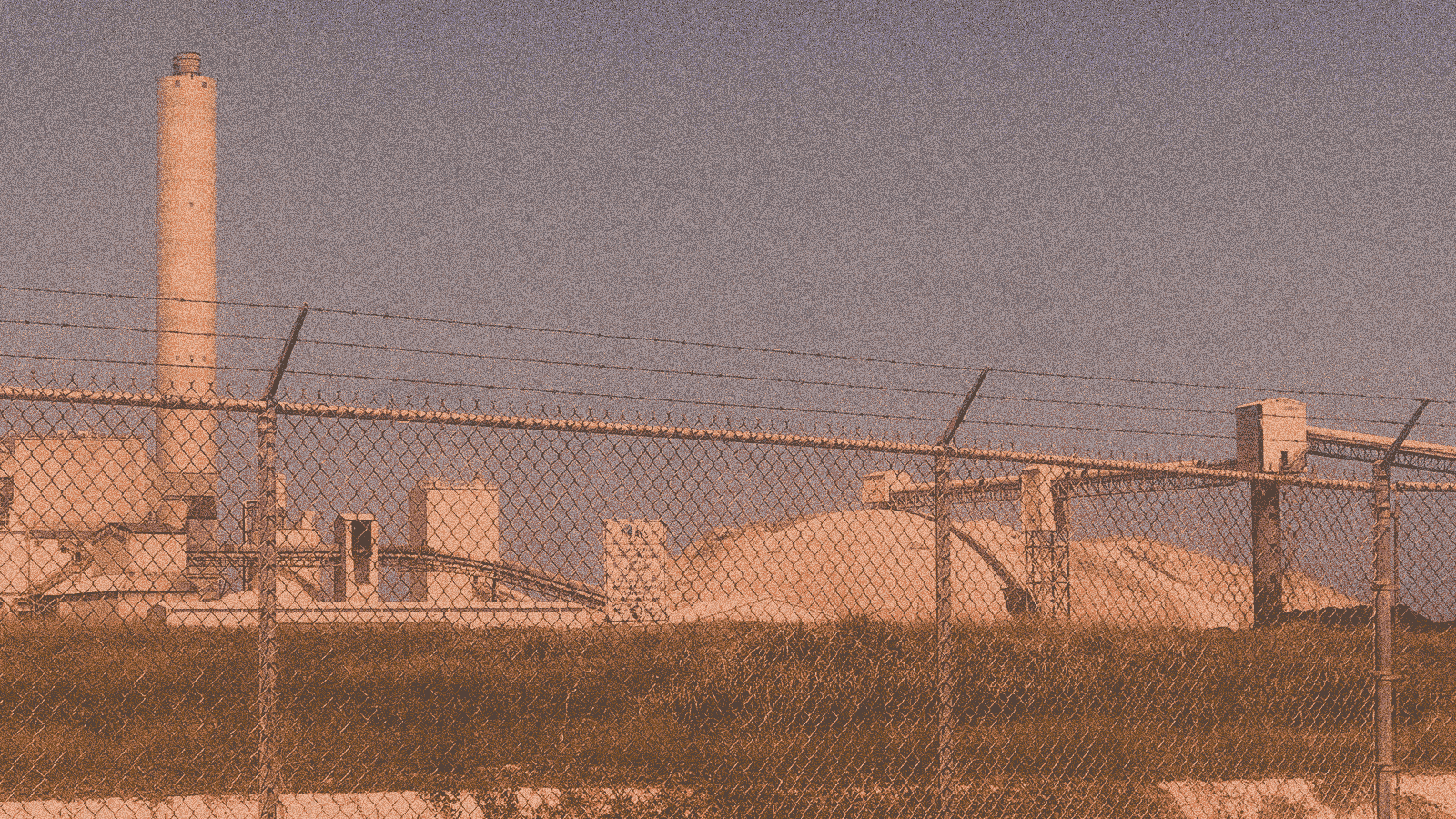On a balmy day this past May, I sat on a white, metal park bench outside of Plaza de Recreo Guanina, a small community meeting space consisting of a few fenced-off trees and a lot of concrete in Miramar, a neighborhood in the southeast Puerto Rican city of Guayama. Just outside the square, a few palm trees swayed in a breeze tinged with just the slightest scent of rotten eggs. A run-down green truck pulled up nearby, and two locals-turned-activists — Aldwin Colón Burgos and Erasmo Cruz Vega — came out to greet me. Upon shaking hands with Cruz Vega — a spectacled man in his early 70s who has called the community home for nearly 60 years — he handed me a white surgical mask. “You’re going to need it,” he said in Spanish.
We piled into the truck and Colón Burgos, a man in his mid-40s clad in t-shirt and jeans, expertly navigated us down a neglected series of public roads. I took Cruz Vega’s advice and kept the mask clamped tightly over my nose and mouth. Less than ten minutes later, we turned onto a street bordering a high chain-link fence. On the other side towered the Applied Energy Systems solid-fueled power plant, Puerto Rico’s only coal-burning facility.
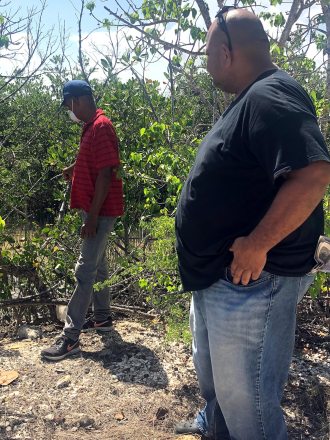
Erasmo Cruz Vega (left) and Aldwin Colón Burgos examine mangroves at a beach near the Applied Energy Systems coal plant. Grist / Paola Rosa-Aquino
As soon as we pulled up, what seemed to be security personnel appeared on the other side of the fence, partially blocking our view. But they couldn’t cover the 120-foot-tall mountain of coal ash — a heavy metal-laden byproduct of the coal burning process. Since the plant opened in 2002, it has produced around 400,000 tons of it per year, which workers have dumped in open-air pits. With nothing to protect the soil and aquifers from potential contamination, each gust of wind is free to carry coal ash particles westward, past the road where we were parked and into Miramar.
Colón Burgos referred to the ash pile as “our Mount Vesuvius.” It only took a few minutes of sitting there staring at it before my eyes were watering and my sinuses began to burn.
While the Applied Energy Systems plant hasn’t buried Guayama, communities in the town and elsewhere in the territory have had a hard time getting authorities to heed their coal ash complaints. The Puerto Rico Environmental Quality Board allowed the company, from 2004 to 2011, to cart over 2 million tons of the toxic ash all over the island and dump it in at least 12 municipalities without structural safeguards. Another 1.1 million tons of ash are unaccounted for, widely assumed to have been deposited in unknown parts of the island. And the coal ash is not limited to the Island of Enchantment: In May, AES announced that ash from Guayama’s coal plant would be transported to Osceola County in central Florida — stalking transplants to the U.S.’s second fastest-growing Puerto Rican community.
Despite the fact that coal is not present naturally in Puerto Rico, coal power from the 520-megawatt AES plant provides a significant amount of the electricity consumed by the island’s energy grid, about 15 percent. In fact, most of the electricity in Puerto Rico, close to 98 percent, comes from burning fossil fuels.
But that could soon change, hastened in part by the devastation the island suffered due to Hurricanes Irma and Maria in 2017. (The latter storm hit Puerto Rico two years ago this week.)
Puerto Rico passed a bill this spring designed to transform its economy by transitioning to renewable energy in an attempt to make its energy grid more resilient. The territory’s former governor, Ricardo Roselló, signed the clean energy legislation in April. Marketed by some as a Green New Deal-style transition for the island, the Puerto Rico Energy Public Policy Act would see Puerto Rico running exclusively on renewable sources by 2050. The bill specifically bans coal plants like AES starting in 2028.
Despite the bill’s passage, according to many locals, officials are struggling to provide a roadmap forward. Roselló resigned amid a corruption scandal over the summer, and the Puerto Rican government essentially played a game of musical chairs where not one, not two, but three governors were all sworn in to lead the territory in less than a week. Wanda Vazquez, the island’s former justice secretary and current governor, has not made a public statement about how she’ll implement the legislation.
A near-total transformation of its current energy mix is a tall order for a territory dealing with instability in its local government, as well as a deeply debt-ridden public utility — Puerto Rico Electric Power Authority (PREPA) recently declared bankruptcy. While the political will might be lacking, and a private takeover over of PREPA is in the offing, environmental advocates on the island are determined to realize the promise of the landmark legislation and allow the island to become self-sufficient — at least when it comes to the energy its people need to survive.
Despite being a significant energy source for the island, the AES coal plant is an unwelcome neighbor for many Guayama residents. Colón Burgos said ash from the plant comes through the cracks of windows in his home, covering furniture, clothing, and bedspreads. And it hasn’t just made its way into houses: An Environmental Protection Agency study, paid for by AES, found that the ash mountain next to the plant is leaching large quantities of chemicals — traces of arsenic, chromium, selenium, and molybdenum — into the island’s groundwater.
The impact of this contamination is most acute for those who live closest to the plant. According to a survey by the University of Puerto Rico’s School of Public Health, almost one in ten people in Miramar have been diagnosed with cancer. Colón Burgos himself was diagnosed with kidney cancer in his mid-30s — a condition he thinks he could have avoided if the coal plant had not moved to town in 2004. (His doctors told him they were used to seeing the disease in people in their 60s and 70s.) From the time the plant opened through 2016, the rate of deaths attributable to cancer in Guayama outpaced the island as a whole by 5 percent, according to the Registro Central de Cáncer de Puerto Rico, guaranteeing the industrial city a spot among the top ten cancer-laden municipalities on the island.
One in four Guayamans have a respiratory disease, and more than half have heart disease. Rates of miscarriages in the region have spiked in recent years. Colón Burgos’ two daughters attend the public school right next to the plant. (“Coal ash even lands in the school’s dining hall, where they’re preparing their food,” he told me,) In 2016, the older one had to have surgery for abnormally large abscesses on her skin. She was 14 years old at the time.
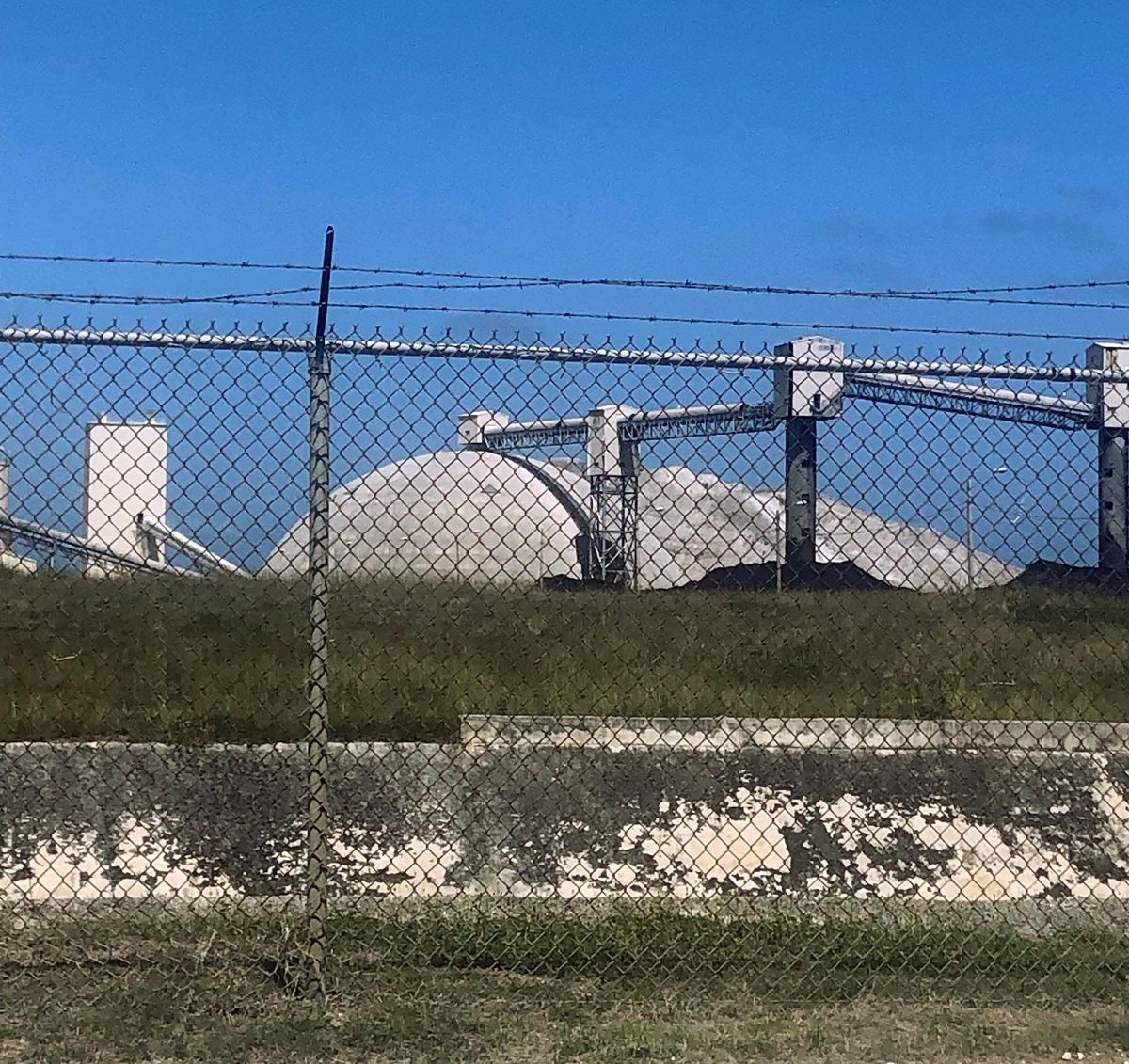
The mountain of coal ash from Applied Energy System’s plant near Guayama supplies 15 percent of Puerto Rico’s energy — despite the island having no coal reserves. Grist / Paola Rosa-Aquino
In July of 2017, before the hurricanes lashed the territory, the Puerto Rican legislature approved a law that prohibits the disposal of coal ash on the island. Coal plant operators, meaning AES, would have 180 days from the day of production to remove the ash — which could be done by converting it to cement, concrete, or another commercially beneficial use. But many environmental advocates, like Timmy Boyle, spokesperson of Alianza Comunitaria Ambiental del Sureste — loosely translated to Southeastern Environmental Community Alliance — think the law is ineffective since AES does not consider its coal combustion residuals to be coal ash. Rather, according to the company, it’s a mix of ash and water called Agremax that can be used in construction. This classification has resulted in the continued storage of thousands of tons of coal ash on the island.
Hurricanes Irma and Maria aggravated the public-health crisis by churning up contaminants in September of that year. The Puerto Rican government fined AES twice for failing to comply with two orders to cover the mountain of ash before the powerful storms passed. The company refused to pay — and the mountain of ashes is still uncovered. Applied Energy Systems declined requests to comment for this story.
Federal regulations exist to protect communities like Guayama. The EPA finalized a rule in 2015 that requires power plants take commonsense precautions when disposing of coal waste. But the agency under Trump, led by former coal lobbyist Andrew Wheeler, has given AES a free pass on cleaning up its mess. The ash impoundments were on a deadline to close in April, but Wheeler granted the company an 18-month extension, local media outlet Centro de Periodismo Investigativo reported, while simultaneously rolling back pollution standards — meaning the mountains could remain exposed indefinitely, even after the Puerto Rico Energy Public Policy Act sunsets the Guayama plant in less than a decade.
When that happens, there are real questions as to whether renewable capacity will be able to take over for the coal plant. Currently, renewable sources make up less than three percent of the island’s energy mix. On my drive from Miramar to the coal plant in Guayama, I passed by Puerto Rico’s largest renewable facility in Santa Isabel, a 101.1-megawatt wind farm — enough to power roughly 40,000 homes — built in 2012 by San Francisco-based Pattern Energy. And the coal plant itself was right next to a field of solar panels, installed by AES, which locals like Colón Burgos dismiss as a PR move. “It’s all about image,” he said.
Aside from these toe-dips into renewable energy, the almost inevitable privatization of the PREPA could complicate any transition away from fossil fuels. The government-owned utility declared bankruptcy in 2017 after decades of mismanagement that resulted in it racking up several billion dollars in debt.
But the embattled utility claims to still have big plans: According to PREPA spokesperson Luis Figueroa Báez, the authority has prepared a detailed proposal to rebuild its power grid into a more resilient system. It includes hardening transmission towers and lines (burying some underground) and splitting the system into mini-grids, each with its own power generation. As part of the effort, he said, PREPA will greatly boost the amount of power generated by renewable energy.
But the privatization of PREPA and the cost required to rebuild its grid could result in unreasonably high electricity bills, with the poorest families bearing most of the financial burden. Add to that the fact that many Puerto Ricans still don’t trust the utility. That’s led some on the island to suggest eschewing PREPA altogether. These energy democracy advocates believe that the best way to shift the territory’s entire energy system to renewable sources might be for islanders to take matters into their own hands.
Conversations about renewable energy aren’t new for the island. Long-standing institutions have been advocating for solar power for years, such as Casa Pueblo.
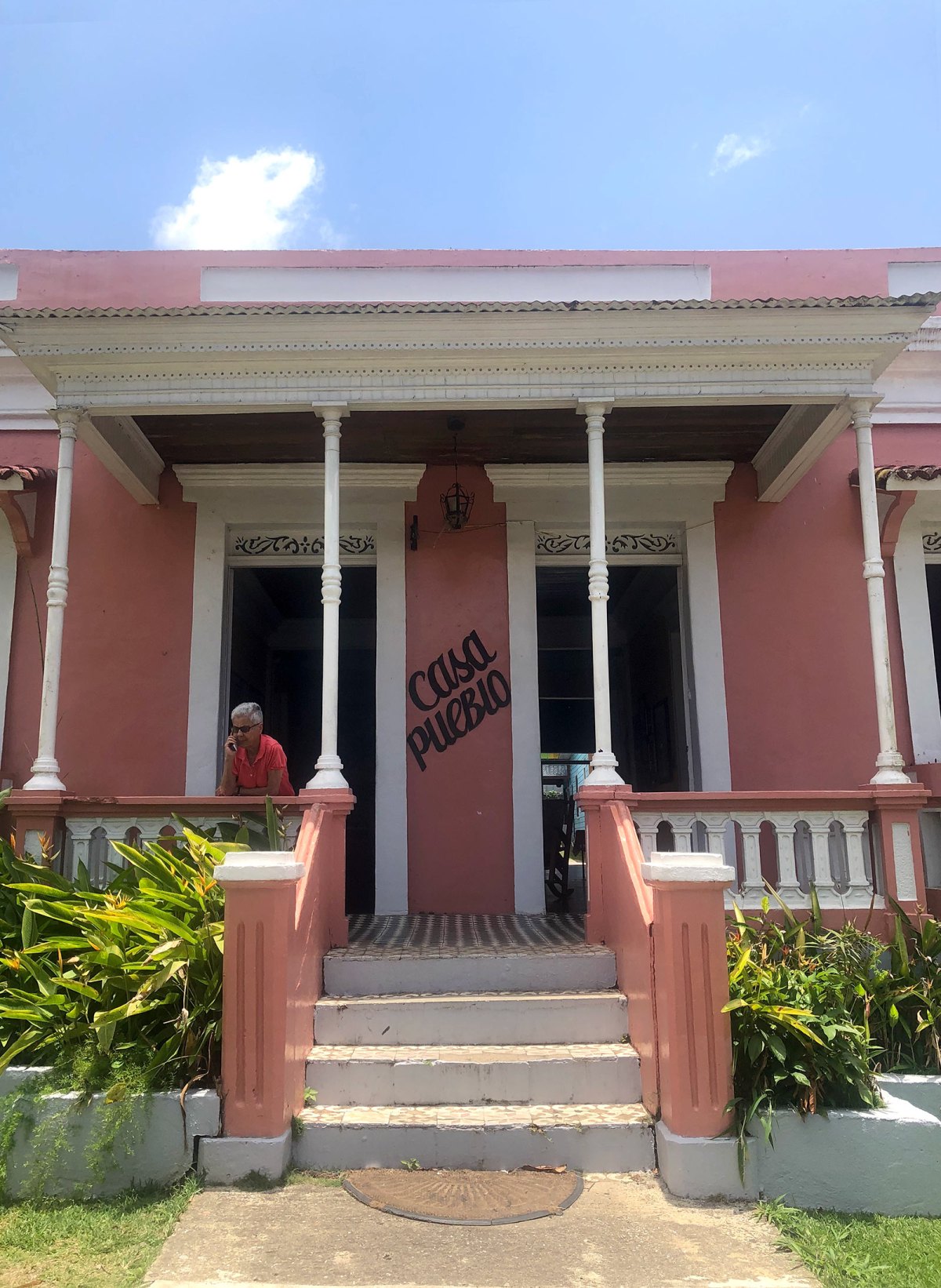
Headquartered in the mountainous town of Adjuntas, Casa Pueblo is a community-based organization focused on, among other things, the protection and management of natural resources. It’s currently focused on spreading the gospel of renewable energy across Puerto Rico. Grist / Paola Rosa-Aquino
Tucked down a street in the mountainous central Puerto Rican municipality of Adjuntas is the small, pink, light-filled building that’s home to Casa Pueblo. Solar panels line the cheerful building’s roof, the lifeline of an organization devoted to educating the public on eco-friendly technology.
The building is nothing short of TARDIS-like (“It’s bigger on the inside,” as they say on the British TV show Doctor Who). Local offerings are sold off to the right of the entrance, including the Madre Isla Coffee the organization has produced since 1989 and that sustains it financially. Further along, a solar-powered fridge stands against the right side of the room; off to the left, a large coffee grinder. There’s more outside, too: A pathway leads to a bright blue building bordering a greenhouse and butterfly garden, as well as Casa Pueblo’s very own radio station, Radio Casa Pueblo 1020. And just outside of the house is a small cinema, filled with seats and a large screen.
Back inside the house, Arturo Massol-Deyá, Casa Pueblo’s assistant executive director, pointed to a picture on the wall. Dating back several decades, it shows a lone protester standing in opposition to an open-pit mining effort. “This all started with one person showing up at the main square to protest open-pit mining,” Massol-Deyá, a biologist by training, told me. He then gestured at another picture on the wall, this one filled with seemingly thousands of people, stretching beyond the frame. “And this is 15 years after, the same square,” he said.
Founded 39 years ago by Arturo’s father, Alexis Massol-González, Casa Pueblo has grown and evolved over the decades, shifting from anti-mining activism to wide-scale renewable efforts. It has run on solar since 1999.
Buoyed by renewable energy after Hurricane Maria, the organization was an energy oasis for Puerto Ricans who suddenly found themselves without power. Casa Pueblo distributed more than 14,000 solar lamps, solar refrigerators, and fully-charged machines for respiratory therapy and dialysis.
Prior to the storm, Casa Pueblo was a small advocacy organization fighting against fossil fuels and for renewable energy — just as it had been against mining. That’s no longer the case. According to Massol-Deyá’s mother, Hurricane Maria ramped up the demand for renewable energy. “There was very little interest before,” she told me in Spanish. “There’s urgency now.”
That new imperative has helped Casa Pueblo spread the renewable energy gospel locally: So far, the organization has installed solar panels on at least two hardware stores and a small barber shop, set up dozens of solar-powered refrigerators around the town, and helped power one of Puerto Rico’s first fully solar-powered restaurants just down the street. It also hopes to equip local grocery stores with solar power as well.
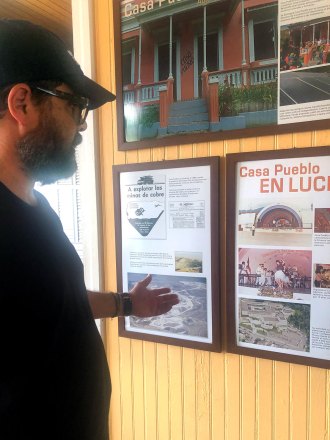
Arturo Massol-Deyá, executive director of Casa Pueblo, describes pictures portraying some of the organization’s early actions against open-pit mining. He has called for an ‘energy insurrection’ on the island. Grist / Paola Rosa-Aquino
“We’re building something different,” Massol-Deyá told me in Spanish. “We’re using our community’s intelligence to manage our reality.”
While Massol-Deyá speaks in grand terms about his organization’s ambitions to bring solar to Adjuntas and beyond, he said he feels skepticism about the former governor’s intentions — “He’s all words,” he told me — at pushing for a transition to 100 percent renewable energy.
And now that Vazquez is at the helm, Roselló’s green bill seems all the more uncertain. The new governor has already suspended a pending $450,000 contract that is part of the program to rebuild and strengthen the island’s power grid. “There is no room in this administration for unreasonable expenses,” she said.
That’s why, Massol-Deyá argues, Puerto Ricans should follow Casa Pueblo’s lead and take matters into their own hands — what he calls an “energy insurrection.”
In April, hundreds gathered in front of the Casa Pueblo headquarters to participate in the “Marcha del Sol,” or Sun March, calling for an uprising to reshape the island’s energy mix. Massol-Deyá isn’t afraid of going against the powers that be, pointing to a picture of himself and a few members of Casa Pueblo getting arrested in Washington, D.C., in 2011 while protesting a natural gas pipeline. “If we have to get confrontational,” he said, “we’ll do it.”
That sense of determination is shared by Aldwin Colón Burgos and Erasmo Cruz Vega, the activists from Guayama. After our trip to see the AES coal plant and its coal-ash mountain, Colón Burgos parked the car near the beach next to the plant. At first glance, we were looking at paradise, a former image of Puerto Rico that for a moment seemed alive and well. But when I looked closer, I could see the mammoth power plant had changed the landscape. The wind has blown ash toward the sea, dispensing its residue throughout nearby mangroves. This threatens both the wildlife in those waters and the livelihoods of community members who rely on the ocean for food, work, and recreation, according to Colón Burgos.
“There seems to be no escaping it,” he said of the plant’s reach — and maybe his island home’s reliance on fossil fuels, as well. “But not on my watch.”
